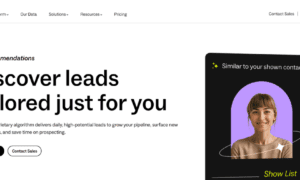If you’re a B2B marketer looking to boost your sales, understanding effective lead generation is key. B2B lead generation involves reaching potential leads who could become customers for your business. To achieve this, you’ll need to identify your target audience, known as the buyer persona, and guide them through a sales funnel.
Creating valuable pieces of content and implementing a robust content marketing strategy can help capture the attention of potential leads. Utilizing methods like email newsletters, ad campaigns, and inbound marketing can further increase your chances of capturing leads and driving sales. This guide will help you improve your B2B lead generation. Resulting in better leads and more success for your B2B company.
Understanding the Importance of B2B Lead Generation
In the business world, finding potential customers is crucial for growth and success in B2B sales. Understanding why finding these potential customers matters a lot in today’s competitive market is crucial for businesses. When businesses find high-quality potential customers, it means they’ve identified people who truly want their products or services. This increases the likelihood of converting potential customers into actual customers and also helps build lasting relationships, keeping customers loyal.
B2B lead generation helps businesses connect with their desired audience, building trust and establishing themselves as industry leaders. This process helps businesses grow and succeed in a competitive setting by providing valuable insights for creating marketing plans. A good plan for sharing useful content is necessary for successful B2B lead generation and maintaining customer relationships.
Identifying your Target Audience
Learning who you want to reach is crucial in any business or communication plan. Knowing your audience helps you create messages, products, or services that fit what they want and like.
Defining Your Ideal Customer Profile
Before diving into B2B lead generation, it’s crucial to define your target audience. Analyze your existing customer base to identify common traits such as industry, company size, job title, and pain points. This helps you create an ideal customer profile and focus your marketing efforts on the segment most likely to benefit from your products or services.
Conducting Market Research
Conduct market research to understand your target audience’s behavior, preferences, and challenges with the help of B2B Rocket. This helps you position your offerings as solutions to specific needs. Knowing more about your ideal customer allows you to customize your marketing efforts. This customization helps generate leads and increase conversion rates.
Creating Compelling Content
Creating compelling content is essential for capturing and retaining the attention of your target audience.
Understanding your Target Audience
Making interesting content begins by truly knowing who you’re trying to talk to. Spend time looking into what your target audience wants, likes struggles with, and finds interesting. This will help you make content that truly matters to them. Using people’s names in your content can create a stronger connection and increase their interest in what you’re saying.
Developing a Content Strategy
To make interesting content, it’s important to have a clear plan. First, determine your content’s goal: educate, entertain, inspire, or motivate people to act. Make sure this plan matches your overall business goals so that your content is consistent and works well.
Crafting Engaging Headlines and Introductions
Getting your audience interested right away is crucial. Create interesting headlines that make people curious and want to click to read more. Then, keep them engaged with a captivating introduction that grabs their attention and sets the mood for the rest of the content.
Using Visuals and Multimedia
Use images and videos to make your content more engaging and appealing. Use visuals like images, charts, videos, or interactive elements to make your content more visually appealing and easier to comprehend. Know your audience, plan your content, make it interesting with visuals, and optimize it for search engines (SEO). Encourage interaction to generate business leads.
Leveraging Social Media Platforms
Leveraging social media platforms can be a powerful strategy to reach and engage your target audience.
Building a Strong Presence on LinkedIn
LinkedIn is a strong tool for businesses to find potential customers. A social media platform that’s especially good for connecting with other businesses. LinkedIn has 700 million professionals worldwide. It’s a good opportunity to connect with your desired audience and establish your brand as an industry leader.
To use LinkedIn well, first, make sure your company page is the best it can be. Provide comprehensive information, such as a detailed overview of your business, your brand logo, and methods for individuals to contact you. Use important words on your page so that more people can find it when they search.
To keep people interested, share helpful stuff and ask your employees to do the same. Get involved in discussions by joining groups and show that you truly know your stuff in your industry. To reach even more people, consider using ads on LinkedIn to get more leads.
Engaging with Twitter and Facebook Communities
Twitter and Facebook are popular social media platforms that can also be leveraged for B2B lead generation. Both platforms have relaxed and diverse users, unlike LinkedIn, but still offer great opportunities to connect with desired people.
On Twitter, utilize hashtags that relate to your topic of discussion and engage with influential individuals in your industry. In Facebook groups, discuss useful stuff and show that you know what you’re discussing. You might also want to think about using targeted Facebook ads to find potential business leads.
Getting recommendations from happy customers can be a strong way to find new business leads. When satisfied customers speak highly of your brand, it can greatly help. Adding live videos and chats to your plan for finding business leads can create conversations in real-time. This can build trust and make more people decide to do business with you.
Implementing Effective Email Marketing Campaigns
Implementing effective email marketing campaigns can help you nurture relationships with your audience, drive conversions, and boost brand awareness. Here are some tips for creating successful email marketing campaigns:
Building a Targeted Email List
To make email marketing work well, you need to start by creating a list of people who are genuinely interested in what you offer. Quality matters more than quantity, so focus on getting subscribers who truly value your products or services. To build this list, give people good reasons to sign up, like special offers. Then, organize your list by things like age and interests so you can send personalized and meaningful emails.
Crafting Personalized and Relevant Emails
When you want to email specific people, it’s crucial to make the emails feel personal and important to them. Personalizing isn’t just about using someone’s name. It means adjusting what you write based on what the person likes, how they act, and where they are in the process of deciding to buy something.
You can use tools that automatically watch and understand how people interact with your emails. Make your email subjects interesting, and make the content inside each email fit each person. Share useful information that discusses the problems they might have and ways to solve them.
A/B Testing and Optimization
To ensure the effectiveness of your email marketing campaigns, it’s important to continuously test and optimize your emails. A/B testing allows you to compare different elements of your emails, such as subject lines, call-to-action buttons, or email designs, to determine what resonates best with your audience.
Test and optimize your emails to improve engagement. Monitor key metrics for insights and make data-driven decisions. Build a targeted email list, craft personalized emails, and continuously improve for effective B2B lead generation.
Harnessing the Power of SEO
Harnessing the power of SEO (Search Engine Optimization) is crucial for improving your online visibility and driving organic traffic to your website.
Conducting Keyword Research
A crucial part of using search engine optimization (SEO) to find potential business customers is doing good keyword research. This means figuring out the exact words and phrases your desired customers use when they’re looking for things your business offers.
To do this, think of words that make sense and use tools that help you find even more words. Make sure to include both short and long phrases in your content so more people can find it.
Optimizing On-Page Elements
Making your website better for search engines is extremely important. To do that, focus on things on your web pages. First, make sure your page titles, meta descriptions, and URLs have the right keywords and describe what each page is about.
Also, make your website content better by using good headings and words that have important keywords. Make your website load faster by making images smaller and using browser caching. This way, more people can find your website easily when they search online.
Building High-Quality Backlinks
Building high-quality backlinks is another important aspect of SEO for B2B lead generation. Backlinks are links from other websites that point to your website, indicating to search engines that your website is trustworthy and authoritative.
Acquire reputable backlinks with relevant anchor text. Monitor and disavow low-quality backlinks. Utilize SEO for better visibility and B2B lead generation.
Utilizing Marketing Automation Tools
Marketing automation tools can streamline your marketing efforts, saving time and improving efficiency.
Streamlining Lead Nurturing and Follow-Up
Marketing automation tools can greatly enhance your B2B lead generation efforts by streamlining lead nurturing and follow-up processes. These tools allow you to automate repetitive tasks, saving time and ensuring consistent communication with your leads.
Use marketing automation for targeted and personalized email workflows. Segment leads and prioritize with lead scoring for effective lead nurturing.
Tracking and Analyzing Campaign Performance
Marketing automation tools provide robust tracking and analytics capabilities, allowing you to measure the performance of your B2B lead generation campaigns. Track key metrics such as email open rates, click-through rates, conversion rates, and ROI to gain insights into the effectiveness of your campaigns. Analyze data to identify trends and optimize campaigns. Use A/B testing to improve strategies and results.
Integrating with Customer Relationship Management (CRM) Systems
Integrating your marketing automation tools with your CRM system is essential for seamless lead management and tracking. This integration allows you to capture and sync lead data, track lead interactions, and provide a holistic view of each lead’s journey.
Integrate marketing automation with CRM for better lead management. Streamline lead nurturing, track campaign performance, and drive better B2B lead generation.
Measuring Success and Making Improvements
Measuring the success of your marketing efforts and making continuous improvements is essential for achieving long-term success.
Setting Key Performance Indicators (KPIs)
Measuring the success of your B2B lead generation efforts requires setting clear Key Performance Indicators (KPIs) that align with your business goals. KPIs help you track and evaluate the performance of your campaigns and identify areas for improvement. Identify relevant metrics and set SMART goals. Monitor and analyze KPIs for effective lead generation.
Analyzing Data and Metrics
Looking at data is crucial to making smart choices and significantly improving your B2B lead generation strategies. Examine the information and numbers you collect from your campaigns to determine what is going well and what can be improved.
Look at the data to find patterns and chances to do better. Split the data into different groups for more personalized strategies. Use pictures and charts to show and explain what you learn from the data.
Making Data-Driven Decisions
Use data analysis to make informed decisions that enhance B2B lead generation by improving the way you identify potential business customers. Make your targeting, messaging, and tactics better based on what you learn from the data.
Try out different things and test what works better (A/B testing). Keep an eye on the results and make changes as needed using the data. By using data to guide your choices, you can make your B2B lead generation better.
Use ads, event marketing, and social shares together to make your efforts in finding business customers even stronger. This can help more people see your brand, bring in the right kind of visitors, and get them interested in what you offer.
Conclusion
Implementing effective B2B lead generation strategies is crucial for driving business growth and success. By harnessing the power of SEO, utilizing marketing automation tools, creating compelling content, and leveraging various marketing channels, you can attract high-quality leads and nurture valuable customer relationships.
Maximize B2B lead generation with B2B Rocket sales automation and lead generation services. Contact them today to achieve your business goals.



































